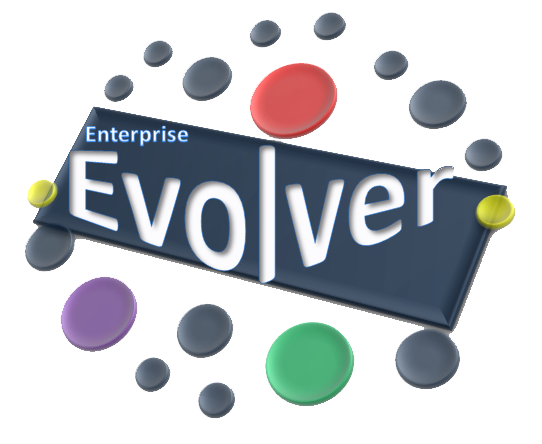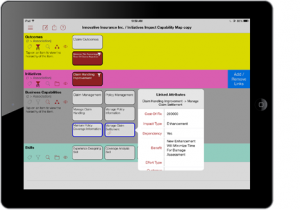The task of mapping an enterprise’s goals, strategies, business capabilities, initiatives and its information systems is key for architecting any enterprise. Mapping a business is the act of capturing the big picture of an enterprise into blueprints depicting the current and or future state of the organization. An enterprise business blueprint is an abstract representation of the business’ reality, but at the same time it is a solid planning and decision making tool founded on concrete enterprise architecture and business design concepts. The enterprise’s leaders, analysts, architects, consultants, managers and designers will use such blueprints of a business in many levels during a business’ market history, and they will in fact paint a portrait of all the real world aspects of the enterprise to get answers to many common questions such as:
- What enterprise parts work together to deliver customer value?
- What business processes are impacted and what data and information is created when customers request for a service?
- What initiatives and efforts are underway to support what customer journey stage?
- What initatives impact what capabilities and what existing capabilities will be enhanced and redesigned and what new capabilities will be created ?
- What journey steps are impacting what touch points?
- What digital resources are used to depict all interactions that our customers have while doing business with us?
- What application systems are used to deliver what services in what customer journey steps?
- What resources are used to deliver what capabilities?
- What business information is created or used in what processes to support what services?
- What customer journey stages are enabled by what capabilities?
- What business goals are supported by what capabilities?
- What services are we building to support the capabilities that were planned?
Blueprints for enterprises are multifaceted data driven maps. From the different perspectives of the many parts involved in any enterprise, from planning, design and management to executive and stakeholder’s levels, there are always many concerns that need to be addressed, and hence the need for many different types of blueprints mapping the whole ordeal. You can create a blueprint to illustrate the operation of your business or create a blueprint for showing how your business capabilities are supported by various organization resources or a blueprint to articulate strategy of the entire enterprise. There is no limit on mapping a blueprint or showing the blueprints from a stakeholder’s point of view. The business capability model, for instance, is an important blueprint that defines what a business does and can be used to help an enterprise in strategic analysis and planning. Executives involved with high level strategic analysis of their organizations can make use of it to serve as a communication medium to align business with IT and prioritize and fund projects and initiatives.
Business consultants do also benefit greatly from modeling capabilities as it can help an organization to find their most critical places to invest and develop heat maps of capabilities to learn and pinpoint what and where are their competitive advantages in the market and enhance, for example, the organization’s ability to invest resources in their true core capabilities that are really important to make a difference in their market presence and not waste money and time blindly on unnecessary efforts.
Another example can be taken from an Enterprise Service Architect that is solving the problems of service granularity and/or determining the service containers within an organization. As a professional responsible for describing integrated and holistic views of an organization into blueprints he or she will need to rely on and strive towards the development of blueprints involving different service maps (e.g. Capability Service map, Service System map) of the whole enterprise when working on an organization’s deep architecture design. When a capability map is linked to a service map and a service map to a system map, the resulting map depicts a relationship between a capability as requirement and service as solution and service system relationship depicts interaction between services and systems. This mappig allows service and system developers to trace their respective services and systems that they are developing back to the capabilities and strategic planners can follow a capability down to its implementation as a software solution.
Recently released Enterprise Evolver (“Evolver”) mobile app from Capability Management Inc., available for iPads in the Apple App Store is a flexible, easy and fun to use tool for creating any kind of data driven blueprints and business maps. With Evolver all levels of a company can have their mapping needs met. Managers, analysts, architects, senior executives and consultants, they all have many types of maps to work within the app: Business Models and Capabilities maps, Initiative Capabilities map, Customer Profile and Customer Journey maps, Business Activity/Process map, Value Proposition map and Value Stream maps, Strategy map , Requirements map. You name it, and there’s a way to create any data driven map that can be used to address many organization questions as highlighted above.
The Enterprise Evolver App
Compared to other business mapping tools and tools like Powerpoint presentation available out there, the Enterprise Evolver is a refreshing take and a great advance on the business productivity tools segment. It allows business and IT professionals to map an enterprise’s big picture fast and reliably using a great combination of Maps, Filters, Tags, extendable meta model and a friendly way to navigate it all. The material created with the app can be presented, compared, analyzed and shared. The creation of blueprints and maps take central stage and one can manage a great deal of map types that help to visualize and understand enterprises fully, ensuring that managers, analysts, architects, designers and consultants develop a deep grasp and appreciation about the goals, operations and capabilities of a business. Enterprise Evolver allows creation of unlimited but distinct number of layers of abstraction in any blueprint and map. These layers are connected to each other by the relationship defined in the meta model between various parts and categories of the business. Tagging feature allows adding keywords to any item in a map. Filter features alow you to view a subset of a map; multiple filters can be used to create a specific view.
Business and IT professionals know quite too well the importance of having intimate knowledge about an enterprise business’s processes, business design and information systems and how the organization deals with its resources, capabilities and customers. When working towards success, it is extremely important to understand that those are constantly evolving factors that need to be always watched, perfected, and especially, addressed quickly when they need fine-tuning. This is exactly where apps like Enterprise Evolver shine and excel, ensuring speed and reliability of the work of these professionals, from the creation starting point to the application of concepts and practices, and passing through the middles steps of discussing, sharing and working collaboratively to achieve a full enterprise map.
Enterprise Evolver Features
There are many great features in the app, like the ability to configure organizational structural elements and parts with custom fields and relations, assessments of resources and business focus areas, identification of under performing assests/resources and capabilities, export to and extract data from MS Excel files via DropBox , support for multiple organizations and a visual Canvas editor that allows the management of all aspects of the map design, from decoration to filtering and searching, and edition of structural elements and connections. For now, let’s take a look at a few of the different maps that can be created with Enterprise Evolver.
Strategic Planning using Capability Model
The capability map, a type of business blueprint, illustrates a set of distinct capabilities that are independent of organization structures, and resources (e.g. people, business processes, products and IT systems) but can be viewed as a container for all the organization resources. Organization capabilities are decomposed into multiple hierarichal levels. Enterprise Evolver’s Repository function is used to capture the capability levels. Once, the hierarchy is captured, you can easily turn this data into a visual capability map using the Canvas Editor.
After the capability map is socialized and published within your organization, you can heatmap the capabilities. Enterprise Evolver offers an intuitive way to perform capability assessment. You can use multi dimension criteria to perform capabilities assessment. Examples of dimensions are Importance, Maturity, Complexity, Criticality, Cost, Satisfaction etc. You can enter a weight for each dimension and create formulas that dynamically use the data entered in the screen to perform useful calculations and generate weighted score.
The capability heatmap produced can be used as an input for strategic planning to demonstrate which capabilities require improvement.
Understanding the impacts of specific projects on the business capabilities is also essential for stragic planning and for prioritizing and funding projects. The Capability- Initiative map can be used to detect redundant capabilities being delivered or enhanced by multiple projects simultaneously. The Capability Initiative Impacts map that are easily created with Evolver help enterprise leaders to better understand the impacts of changes on capabilities and the cost for building or enhancing a capability. The map below provides many insight to strategic planners such as capability impact type , cost to fix and the skills requirement to support the enablement of the capabilities and what outcome will be achieved as part of the capability enhancement.
Customer Journey Maps
Being able to comprehend your customers’ interactions with your products and services is absolutely fundamental and key for managing customer experience. The customer journey maps you create with Evolver will give you a full view of the customer experience and clarify pain points that the customers may face. This is incredibly helpful for any business designer to identify Touchpoints in need of improvement, the experience requirements for these improvements, and to enhance the customers’ overall experience. You can link customer journey map to your organization capabilities to understand what capabilities are adding value and enhancing customer experience at each touchpoints.
Maps Comparision
Comparing two maps are essential to find gaps between current and future state of the blueprint. This functionality is used to find the gaps between two states of a map, i.e. current state and future state of capability map or any other category. A unique item within a map row is bordered by red color. These items are considered gaps between two states of the maps that you are comparing.
Business Operational Blueprint
There is surely more, and you should most definitely try Enterprise Evolver. It is a highly recommend software for anyone dealing with the complexities of business and entreprise architecture mapping. In essence, a fundamental tool to be used constantly for any serious approach at strategic planning, enterprise architecture, solution development, enterprise analysis and impact analysis. Like the app motto says, “Evolve your business and get ahead”.
To download from the Apple Store , tap here. For an enterprise license, contact us using this link.






